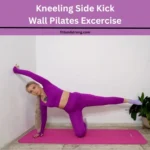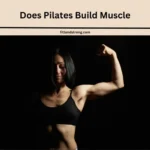Whether you want to do Wall Pilates or you are wondering about the results of Wall Pilates, can you expect results from such simple exercises or not? Today’s post will clear all your doubts about how to get the best out of it.
Till now I have had many practical experiences with exercises and also read top-notch scientific research. I would like to share a very important thing with you about getting the best outcomes.“Just expecting good results from any type of exercise is worse and a waste of your time”.
If you want to Lose Weight seriously with Wall Pilates in a short time or want to tone your body and get abs.

So you should focus on the Five Components of Fitness with Wall Pilates and include them in your journey. Which will not only help you in giving better results but will also make you fit and strong for life long.
To be honest I can’t believe it after seeing the results of so many people who Learned Wall Pilates via my website and got amazing results. Let us understand this in some detail and try to know what experiences different people had in their journey.
What is Wall Pilates?
Wall Pilates utilizes a bare wall to perform variations of popular Pilates exercises. It’s a creative twist on traditional methods. Originally, Joseph Pilates developed this method to connect the body and mind.
This approach can significantly increase the range of motion and difficulty of the movements. Using just a wall, practitioners can improve core stability, overall strength, and flexibility without emptying their wallets on costly Reformers or Club Pilates memberships.
Fundamental exercises are performed on the floor, but Wall Pilates brings an exciting change. Advanced movements, previously limited to apparatuses like the Reformer, Wunda Chair, High Chair, and Ladder Barrels, are now accessible. This addition of a bare wall lets Pilates aficionados up the ante in their workouts safely and effectively.

The transition from floor to wall exercises challenges the body in new ways. Even advanced practitioners find fresh hurdles to conquer. It incorporates a unique collection of exercises designed during World War II. These exercises aim to develop a deep connection between body and mind.
Before trying Wall Pilates, I was skeptical about the range of motion improvements it promised. However, after consistent practice, the results were undeniable. My core stability has never been better, and my overall strength and flexibility have significantly improved.
Incorporating a bare wall into my Pilates routine was a game-changer. It allowed me to perform variations of exercises that increased difficulty and enhanced my workouts. The simplicity and effectiveness of Wall Pilates have made it a staple in my fitness regimen.
3 Wall Pilates Challenge which Many have tried to get results
Well, wall exercises are nothing new, I have been doing them in different ways for a long time at home, in the gym, or in my fitness routine. But Wall Pilates is the latest exercise concept that has brought results to many people.
I have achieved results from Wall Pilates Through All Seasons myself and have also given results to many of my students of different age groups or health conditions.
Seeing the popularity of Wall Pilates for the past 12 months, I have posted different types of workout challenges through my website, like 3 Trending Wall Pilates Challenges. which are absolutely free or any person can easily do them in just 15-20 minutes every day.
The 21-Day Killer Wall Pilates For All is the best results-giving challenge is quite popular and is not available anywhere for free. Social media or Pilates apps charge a little for this.
Additionally, I’ve led a 28-day Pilates Challenge: Complete Guide that had over a million views. I’ve read through hundreds of comments and can tell you what makes people consistent and what makes them drop off.
But while following this, many people have also made some different mistakes. I will share with you through which you can easily get results with all the benefits of Wall Pilates without making any mistakes.
Avoid these 3 Mistakes for Best Results
I’ve led a 30-day Pilates challenge; this post had over a million views. I’ve read through hundreds of comments and can tell you what makes people consistent and what makes them drop off.

Mistake 1: Not Planning
Mistake number one happens before you even do a single workout and that is not mapping out a plan. You need a few things in place that will guide you as the days go on, as motivation goes down, and then discipline needs to kick in.
How to Plan
- The most successful challenge participants will print off the plan or save it to their phone and check it off each day.
- Having an accountability partner or commenting on the video after each workout for accountability.
- Visually seeing your progress is incredibly helpful.
Mistake 2: Weight Loss Misconceptions
Mistake number two is assuming exercise alone will equal weight loss.
My Habits for Weight Management
- I eat a high protein, high-fat breakfast, like eggs and avocado.
- I serve things on small plates and like my sweets to be small.
- Prioritizing fiber and making sleep a big priority.
Mistake 3: Stress Kills Results
The most overlooked mistake is not being proactive about managing your stress on a daily basis.
Managing Stress
- Ask yourself how can you set up your day to tolerate the discomfort of the change you want to make.
- You might need to start having hard conversations, going to therapy, or reading more about putting down boundaries.
Wall Pilates Exercises That Give Surprising Results
I have always included 13 Best Wall Exercises in my fitness routine and also given a guide to my students, family members, and friends to follow.
Wall Lunges
Although there are many types of lunges, but wall lunges are different from them all. There are more than 3 Types of Wall Lunges that I recommend depending on the physical ability of the individual and there are a variety of levels, from very easy to normal which I have explained in a specific post.
Wall Teaser
The teaser is an exercise that’s definitely worth learning. It helps develop better strength, flexibility, control, and balance. When done properly, the Wall Pilates Teaser Exercise significantly contributed to a flatter tummy in my experience.
This variation of the teaser was a game-changer for me. Initially, it was tricky; I could not hold onto my legs or maintain control. However, this exercise taught me how to reach from my legs and provided valuable feedback. I encourage everyone to try it and let me know how it goes.
Wall Angle
Wall angels, also known as the V to W stretch, start and end with specific arm positions. It’s typically performed with your back against a wall, which provides feedback, ensuring your spine stays neutral and your arms maintain the correct position.
This exercise is especially beneficial for those who sit most of the day or are engaged in upper-body resistance training. It not only aids in posture correction but also strengthens the shoulder region, making daily activities more manageable and less strenuous.
Wall Glute Bridge
The wall bridge, a modified version of the glute bridge, targets and strengthens the glutes to a greater degree. This exercise not only improves hips’ range of motion but also boosts circulation. It Tones The Core and thighs, serving as a corrective measure.
By teaching the body the sequencing and synchronization from the ankle to the lumbar spine, it’s comfortable in relative lumbar flexion in an unload position. It also aids in creating separation and distraction of the tissue at the thoraco-lumbar junction.
Overall, the wall glute bridge is an effective exercise for those looking to enhance their lower body strength and mobility or to Shape a Perfect Butt with Wall Pilates. It’s especially beneficial for improving posture and alignment.
Wall Squat With Ball
The Swiss ball body-weight wall squat is ideal for beginners looking to strengthen their lower body and core. Performing this Exercise Against The Wall with a ball enhances stability and adaptation to the movement pattern.
By incorporating the Swiss ball, beginners can safely adapt to squatting movements. This exercise not only develops strength but also promotes a new, healthier pattern of movement in daily activities.
How Did People Benefit From it?
After listening to the progress of many people, I found out that even more than 27 Wall Pilates Benefits can be achieved, which I have explained in my previous post.
Wall Pilates has been a game-changer in improving people’s stability, balance, and strength. Many found it more comfortable and accessible in their home setting. Callie Jardine, a renowned Pilates instructor and founder of Sweaty Studio, emphasizes its unique approach compared to traditional Pilates.
Unlike regular routines, Wall Pilates involves keeping the feet elevated during the workout. This change has led to increased circulation, improved digestion, and better sleep for many.
Participants also reported reduced muscle cramps, highlighting its effectiveness. Jardine notes this as a key benefit.
The addition of the wall as a resistance tool in workouts eliminates the need for extra equipment. This simplicity has made Wall Pilates popular among those seeking to enhance their physical control and overall well-being. It’s not just a fitness trend; it’s a lifestyle enhancement.
1.It’s low impact
People and research found Pilates highly effective in reducing the risk of injuries, especially in sports. Its low impact nature is kind to joints and muscles, preventing high-impact movement-related strain. Nolan explains this makes it ideal for injury rehab.
2. The wall provides stability
The wall in Pilates provides crucial stability for those wobbly with their balance. It offers the support needed to perform exercises in proper form, making the workout more effective. Nolan observes this leads to a winning fitness strategy.
3. The wall can help with alignment
In terms of alignment, the wall plays a key role. Nolan notes it helps in lying straight or standing against it, aiding in determining if one’s posture is fully correct. Great for those practicing at home without an instructor to guide.
4. The wall provides free resistance
Initially not feeling the need for buying Pilates equipment, I found the wall a perfect substitute. It provides free resistance, adding assistance and extra challenge to routines.
Surprisingly, exercises I thought wouldn’t be effective without equipment proved more rewarding.
Nolan’s insight was invaluable. For example, doing the bridge exercise with feet up against the wall made a significant difference.
My hips lifted higher, engaging my hamstrings and glutes to work harder. This made my workout on the wall more effective than on a mat with feet flat on the floor.
5. It can be done at home
Wall Pilates can easily be done at home, a significant benefit for many. Nolan highlights that you don’t need anything but a mat and yourself. There are plenty of free online classes to follow, making it accessible and convenient.
Science has shown general benefits of Pilates, with a review of nine studies indicating an increase in muscle mass and a decrease in body fat. While there’s little research specifically supporting wall Pilates, experts are unanimous in recognizing wall-specific rewards to be reaped.
7 Things O’Connor Learned Doing Wall Pilates for 28 Days
Keltie O’Connor, an Athlete, pledged to practice wall Pilates every day for two weeks. Inspired by social media feeds flooded with its popularity, she dived in. Her YouTube video reveals she was intrigued by the algorithm-driven trend.
Over the next 14 days, she tried the most popular workouts on platforms like Instagram, TikTok, and Pinterest. Her goal was to discover if they were worth the time. Here’s what she found: wall Pilates is more than a fad.
1. It’s Not As Easy As It Looks
O’Connor began her 14-day challenge with enthusiasm, searching for the top wall Pilates workouts on Google. On day one, she chooses a 20-minute session, seemingly simple, aimed at beginners.
Her initial expectation was a challenge akin to a vacay, easy and relaxing. But she quickly realized, after struggling with the first exercise, that her ego had misled her. It was far from simple.
She found Pilates difficult because it’s different from higher intensity forms of workouts like running and weights sessions, which focus on achieving a certain distance or number of reps. Pilates, in contrast, requires more control and concentration.
In Pilates, you’re forced to slow down, with less to distract you, making it bloody hard. Breathwork, one of Joseph Pilates’ key principles, demands engagement of deep transverse abdominis muscles in the core.
This contrasts with other exercises like weightlifting, where these core muscles may get the opportunity to kick back and relax. O’Connor found this aspect particularly interesting and challenging.
As O’Connor became stronger, Pilates remained challenging. Improved practice meant better form, which paradoxically made it more difficult. Yet, the harder it feels, the more effective it is, proving that perseverance pays off in Pilates.
2. Form is Key
It’s not news that how you execute an exercise can determine its effectiveness. In wall Pilates, O’Connor experienced firsthand the repercussions when form fails. Her lower back started hurting, showing the importance of right form.
She realized she gotta do better, acknowledging there’s much room for improvement. This was a crucial learning during her challenge. Pilates, originally used for rehab, emphasizes the benefits of maintaining concentrated form.
O’Connor adds that the problem with Pilates being so trendy is anyone can post exercises on the internet. Without knowing if they’re qualified, it’s hard to know if what’s being shown is right.
Our advice? Always check the bios of social media accounts for inspo. If they’re a certified trainer, they’ll likely say so. If unsure, consult our complete Pilates Guide for reliable guidance.
3. It’s Up to You to Create Resistance
On day three, O’Connor really recognises the importance of control, a key principle of Joseph Pilates. Hard work is needed to make progress, she explains. It’s about how you engage your body.
When doing exercises, O’Connor swings her legs up and down, demonstrating a lack of control. To effectively squeeze your glutes and core, slower movements are essential. It’s not just about motion, but how it’s done.
The slower you take an exercise, the more time your muscles spend under tension, becoming more intense. This approach, backed by research in the Journal of Physiology, increases Time Under Tension (TUT), optimizing muscle growth.
A study “Complexity” shows that slowing down exercises makes them harder. This requires more stability, coordination, balance, power, agility, and strength. It’s about the quality of each movement.
Swinging your arms and legs is a common mistake that adds momentum. This means your muscles aren’t fully pulling their weight. Controlled movements ensure that each muscle works effectively.
4. Don’t Wear Socks
O’Connor discovered a practical tip: practice wall Pilates bare foot. She noted the awful grip with socks during her third session. Going bare foot isn’t just a preference; it’s safer and enhances stability.
She reiterates the importance of this approach after finding it dangerous to do wall Pilates with socks. Proper foot traction is essential for maintaining balance and control during exercises.
5. It Might Be More Practical to Do Wall Pilates at Home
O’Connor completed the majority of her challenge at home, highlighting the benefits of Pilates. It requires minimal equipment, and there’s no need for a gym membership. This makes it accessible and convenient.
On the one day she headed to the gym, she faced a problem: there were no bare walls to use for exercises. She had to adapt and use a pillar, a reminder to keep in mind how gyms typically store equipment against walls.
Performing Pilates at home offers the freedom and space that gyms may not always provide, making it a more practical choice for many.
6. Wall Pilates: Versatile for All Levels
On day nine, O’Connor shares insights from her mum, a Pilates instructor with 30 years of experience. She learned how wall Pilates can be a good, stable environment for beginners. Performing basic exercises like the hundred against a wall helps build confidence as you progress.
For the more advanced people, who’ve mastered the exercises, wall Pilates becomes a great way to add intensity to each move.
Techniques like wall sits can transform the routine into a more complex workout. It’s a versatile tool that makes workouts either easier or more challenging.
O’Connor’s conversation with her mum highlights that whether you’re just starting or have been practicing for years, wall Pilates adapts to every skill level. This adaptability ensures continual growth and challenge for everyone.
7. Form is the Best Metric to Track Progress
Last month, She completed a 30-day Pilates Challenge. One limitation was how to track progress without a measurable metric.
Andy Vincent, a strength and conditioning coach, explained it’s hard to gauge progression in Pilates compared to Weightlifting, which is easier because you can increase weight or reps.
He advised using time under tension as a progression factor, but caveated that it’s difficult to track. You’d have to stop after every exercise in your workout to note down how long you were performing it, making it tricky to know which muscles were engaged and for how long.
For O’Connor, her form became the most effective metric to monitor her improvements. Unlike running, where you can see yourself getting faster, or weights, where you become stronger, with Pilates, you observe improvements in moves, better form, less pain, and better mobility.
Despite not seeing much physical change in her body, O’Connor found improved form to be rewarding. She thought, “I wanna get better and better.” This mindset highlights the value of focusing on technique over aesthetics.
If you’re a beginner, filming short clips of exercises you improve on each week is suggested. When you look back over time, you’ll be pleasantly surprised by your progress.
What are the Drawbacks of Wall Pilates?
Starting wall Pilates at home can seem like a great idea. It promises flexibility and strength without the gym hassle. But, it’s not all perfect. The lack of feedback and correction from a teacher can be a major limitation.
It’s important to work in the correct alignment, move with precision, and apply your breath correctly to engage your muscles fully. Without this, you might not see the benefits you’re hoping for.
As a beginner, Lara quickly realized she needed assistance. I advise that without guidance, especially during intense exercises, failing to engage the core potentially does more harm than good.
Although it’s rare, the risk that the bad outweighs the good exists. This was a wake-up call for her to seek some level of instruction.
The routine can get limiting and dull if wall Pilates is your only form of exercise. I love to mix up my workouts with extra resistance and challenges. Adding weights and props brought new life to my sessions, offering the variety I craved.
Incorporating floor exercises like plank work, where you can use your body weight as resistance, opened up new possibilities. It was a game-changer for anyone, showing that mixing different types of exercise could enhance my practice significantly.
Although starting wall Pilates might seem straightforward, navigating its limitations requires creativity and a willingness to adapt. Using props and seeking out workouts that complement the wall work can provide a well-rounded fitness regimen.
Conclusion
After diving deep into Wall Pilates, it’s clear this exercise is a big win for anyone looking to shake up their fitness routine.
From the comfort of home, without needing fancy gear, Wall Pilates offers a solid workout that hits all the right spots: strength, balance, and flexibility. It’s perfect for folks at any fitness level, whether you’re just starting out or you’ve been at it for years.
What’s super cool is seeing how Wall Pilates fits right into any schedule, no matter how packed it is. Sure, there might be a few bumps along the way, like figuring out the best way to tackle certain moves without straining your neck or feeling a bit awkward. But that’s just part of the process.
So, if you’re thinking about giving Wall Pilates a whirl, definitely go for it. It’s a fresh take on getting fit that’s both effective and fun. You might not see a drastic change overnight, but the progress in how you move and feel will have you coming back for more.






I was suggested this web site by my cousin Im not sure whether this post is written by him as no one else know such detailed about my trouble You are incredible Thanks
thanks, If you have any further doubt then you can ask me in comment, I will try to help you completely.